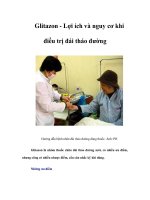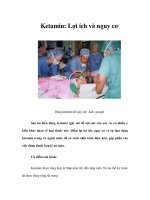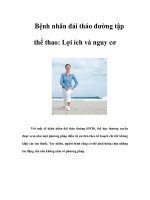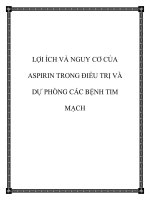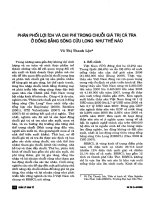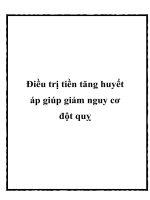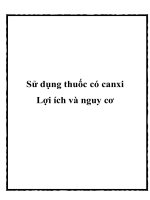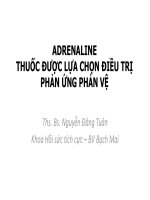glucocorticoid trong điều trị sốc phản vệ lợi ích và nguy cơ
Bạn đang xem bản rút gọn của tài liệu. Xem và tải ngay bản đầy đủ của tài liệu tại đây (8.4 MB, 40 trang )
BS. BÙI VĂN KHÁNH
và
• Sơ lược về Glucocorticoids
• Cơ chế sốc phản vệ
• Lợi ích của Glucocorticoid trong SPV
• Nguy cơ của Glucocorticoid trong SPV
• Ca lâm sàng chẩn đoán nguyên nhân SPV do
thuốc
1855 – Bệnh Addison (Bs Thomas Addision)
1856 – Tuyến thượng thận cần thiết cho sự sống (SL
Charles Edward)
1930 – Cấu trúc và tổng hợp các steroids (Hench)
1932 – Hội chứng Cushing(Harvey Cushing)
1948 – Lần đầu tiên dùng cho người (29/F/Đau khớp)
1950 - Hench đạt giải Nobel
1980 - Vai trò chống viêm của GCs được làm rõ
???: GCs được chỉ định cho bệnh nhân sốc phản vệ
N Engl J Med 2005;353:1711-23.
Eur Arch Otorhinolaryngol (2011) 268:247–253.
GENOMIC
• Hoạt hoá gen: Annexin-1, thụ thể
beta2-adrenergic , ức chế NFkB, LI-
1RA, IL-10
• Kiềm chế gen:
• Trực tiếp: yếu tố giải phóng
corticotropin, osteocalcin, keratins
• Gián tiếp:
• Cytokines: IL-1, IL-2, IL-3, IL-4, IL-
5, IL-6, IL-9, IL-11, IL-13, IL-16, IL-
17, IL-18, TNFα, GM-CSF
• Enzymes: tổng hợp NO, COX
• Thụ thể: Bradykinin beta-2,
tachykinin NK1, NK2
NONGENOMIC
• Tác dụng trên kênh ion trên màng tế
bào
• Tác dụng lên các dấu hiệu truyền tin
của thụ thể lympho bào T
N Engl J Med 2005;353:1711-23.
viêm
Giữ muối
Thời gian
tác
dụng (
h)
Chỉ định
Tác dụng
ngắn
Hydrocortisone
1 1 8-12
Suy thượng
thận
Cortisone
0.8 0.8 8-12
Tác dụng
trung bình
Prednisone
4 0.8 12-36
Chống viêm
Ức chế miễn
dịch
Prednisolone
4 0.8 12-36
Methylprednisolone
5 Rất ít 12-36
Triamcinolone
5 0 12-36
Tác dụng kéo
dài
Dexamethasone
30 Rất ít 36-72
Chống
viêm/
ức
chế miến dịch
Betamethasone
30 Gần 0 36-72
Tác dụng giữ
muối nước
Fludrocortisone
10-15 125-150 12-36
Điều trị thay
thế aldosterone
Liu et al. Allergy, Asthma & Clinical Immunology 2013, 9:30
Liu et al. Allergy, Asthma & Clinical Immunology 2013, 9:30
GCs
Đợt cấp HPQ
trung bình và
nặng
Đợt cấp
COPD
Viêm mũi dị
ứng
Viêm da dị
ứng
SỐC PHẢN
VỆ
Dị ứng thuốc,
thức ăn
Viêm phổi dị ứng/
viêm phổi tăng
bạch cầu ái
toan/viêm phổi kẽ
Mày đay
cấp/phù
mạch
Tế bào Mast Bạch cầu ái
kiềm
Bạch cầu ái
toan
Đại thực bào Bạch cầu Mono
HISTAMINE
LEUKOTRIEN
THROMBOXANE
PROSTAGLANDINS
YẾU TỐ HOẠT HÓA TIỂU CẦU
TRYPTASE
CHYMASE
CARBOXYPEPTIDASE
HEPARIN
YẾU TỐ HÓA ỨNG ĐỘNG VÀ HOẠT HÓA BẠCH CẦU ÁI TOAN
TNF
Bằng chứng y học của GCs và vai trò trong
sốc phản vệ ?
Thiếu RCT, Meta-analysis, Review
Kết luận: không có bằng chứng khoa học chứng minh được lợi ích của
việc sử dụng GCs trong điều trị cấp cứu sốc phản vệ
Trong thực tế GCs có vai trò thế nào trong
sốc phản vệ ?
Resuscitation Council (UK)
EMERGENCY TREATMENT OF ANAPHYLACTIC REACTIONS
20
When skills and equipment available:
• Establish airway
• High flow oxygen Monitor:
• IV fluid challenge
3
• Pulse oximetry
• Chlorphenamine
4
• ECG
• Hydrocortisone
5
• Blood pressure
1
Life-threatening problems:
Airway: swelling, hoarseness, stridor
Breathing: rapid breathing, wheeze, fatigue, cyanosis, SpO
2
< 92%, confusion
Circulation: pale, clammy, low blood pressure, faintness, drowsy/coma
3
IV fluid challenge:
Adult - 500 – 1000 mL
Child - crystalloid 20 mL/kg
Stop IV colloid
if this might be the cause
of anaphylaxis
4
Chlorphenamine
5
Hydrocortisone
(IM or slow IV) (IM or slow IV)
Adult or child more than 12 years 10 mg 200 mg
Child 6 - 12 years 5 mg 100 mg
Child 6 months to 6 years 2.5 mg 50 mg
Child less than 6 months 250 micrograms/kg 25 mg
2
Adrenaline (give IM unless experienced with IV adrenaline)
IM doses of 1:1000 adrenaline (repeat after 5 min if no better)
• Adult 500 micrograms IM (0.5 mL)
• Child more than 12 years: 500 micrograms IM (0.5 mL)
• Child 6 -12 years: 300 micrograms IM (0.3 mL)
• Child less than 6 years: 150 micrograms IM (0.15 mL)
Adrenaline IV to be given only by experienced specialists
Titrate: Adults 50 micro
g
rams; Children 1 micro
g
ram/k
g
Figure 3. Anaphylaxis algorithm
Adrenaline
2
• Call for help
• Lie patient flat
• Raise patient’s legs
Diagnosis - look for:
• Acute onset of illness
• Life-threatening Airway and/or Breathing
and/or Circulation problems
1
• And usually skin changes
Airway, Breathing, Circulation, Disability, Exposure
Anaphylactic reaction?
GCs- fluocinide: làm giảm thâm nhiễm tế bào mast tại mô và
làm tăng quá trình chết theo chương trình của tế bào mast.
Clinical and Experimental Immunology,2012 170: 86–93
Clinical and Experimental Immunology, 2012.170: 86–93
GCs có thể gây ức chế sự hoạt động
của tế bào bạch cầu ái kiềm thông qua
việc hình thành hàng tỷ phân tử lipid để
gắn vào các GCR trên màng bạch cầu ái
kiềm dẫn tới ức chế hoạt hoá tế bào
này
Resuscitation Council (UK)
EMERGENCY TREATMENT OF ANAPHYLACTIC REACTIONS
20
When skills and equipment available:
• Establish airway
• High flow oxygen Monitor:
• IV fluid challenge
3
• Pulse oximetry
• Chlorphenamine
4
• ECG
• Hydrocortisone
5
• Blood pressure
1
Life-threatening problems:
Airway: swelling, hoarseness, stridor
Breathing: rapid breathing, wheeze, fatigue, cyanosis, SpO
2
< 92%, confusion
Circulation: pale, clammy, low blood pressure, faintness, drowsy/coma
3
IV fluid challenge:
Adult - 500 – 1000 mL
Child - crystalloid 20 mL/kg
Stop IV colloid
if this might be the cause
of anaphylaxis
4
Chlorphenamine
5
Hydrocortisone
(IM or slow IV) (IM or slow IV)
Adult or child more than 12 years 10 mg 200 mg
Child 6 - 12 years 5 mg 100 mg
Child 6 months to 6 years 2.5 mg 50 mg
Child less than 6 months 250 micrograms/kg 25 mg
2
Adrenaline (give IM unless experienced with IV adrenaline)
IM doses of 1:1000 adrenaline (repeat after 5 min if no better)
• Adult 500 micrograms IM (0.5 mL)
• Child more than 12 years: 500 micrograms IM (0.5 mL)
• Child 6 -12 years: 300 micrograms IM (0.3 mL)
• Child less than 6 years: 150 micrograms IM (0.15 mL)
Adrenaline IV to be given only by experienced specialists
Titrate: Adults 50 micro
g
rams; Children 1 micro
g
ram/k
g
Figure 3. Anaphylaxis algorithm
Adrenaline
2
• Call for help
• Lie patient flat
• Raise patient’s legs
Diagnosis - look for:
• Acute onset of illness
• Life-threatening Airway and/or Breathing
and/or Circulation problems
1
• And usually skin changes
Airway, Breathing, Circulation, Disability, Exposure
Anaphylactic reaction?
GLUCOCORTICOIDS GÂY SỐC PHẢN VỆ
CÓ HAY KHÔNG?
Năm Tác giả Quốc gia/tạp chí Loại GCs
Đặc điểm
bệnh nhân
Phương pháp chẩn đoán
2002
Burgdorff
et al
US/
Annals of Allergy,
Asthma,
and
Immunology
Methylprednisolone
hydrogen succinate
42/M? xơ
cứng bì
Test
lẩy da(+++) với
methylprednisolone
-21-
sodium succinate
và
prednisolone
-21-sodium
succinate
IgE
đặc hiệu với M(+)
2003
Karsh
et al
US/
Annals of Allergy,
Asthma, and
Immunology
Triamcinolone 75/M/?
Test
lẩy da (++)
2007 Ventura
et al
Italy/International
Journal of
Immunopathology and
Pharmacology 20.2 (Jun
2007):387
-391
Betamethasone
disodium
phosphate
?/F/?
Test
lẩy da (++)
2008
Escobosa
et al
Tây
ban nha/J of
Investigational
Allergology
and Clinical
Immunology
Methylprednisolone
hydrogen succinate
32/F/ Viêm
mũi dị ứng/
HPQ
Test
nội bì/test kích thích(-
/+++)
2011
Annett et
al
Int Arch Allergy
Immunol 2011;155:86
–
92
Methylprednisolone
hydrogen succinate
26/M/ong đốt
70/M/Điếc
Đột ngột
Test
lẩy da (++)
BAT(++)
Test
kích thích (++)
Respiration 2002;69:309-313
